Mechanical, Chloride Permeation, and Freeze–Thaw Resistance of Recycled Micronized Powder Polypropylene-Fiber-Engineered Cementitious Composites
Abstract
:1. Introduction
2. Experimental Preparation
2.1. Materials
2.2. RMP Preparation Process
2.3. RMP-PP-ECC Mixing Ratio Design
2.4. Microstructural Test
2.5. Methodology of the Experiment and the System for Applying Loads
2.6. Chloride Ion Permeability Testing
2.7. Freeze–Thaw Cycle Resistance Test
3. Analysis of Experimental Phenomena and Results
3.1. Experimental Phenomena of RMP-PP-ECC Damaged by Force
3.2. Analysis of Experimental Results
3.2.1. Heat of Hydration Analysis of RMP and Recycled Micronized Cementitious Systems
3.2.2. XRD Analysis of Cementitious Materials
3.2.3. Compressive Strength of Cubes
3.2.4. The Flexural Strength of RMP-PP-ECC
3.2.5. The Tensile Strength of RMP-PP-ECC
3.2.6. Uniaxial Tensile Stress–Strain
3.2.7. Uniaxial Strength Analysis
3.2.8. SEM Analysis of Fracture Surfaces of Tensile Specimens
3.2.9. Effect of RMP-PP-ECC on Anti-Chloride Permeation Performance
3.2.10. Effect of RMP-PP-ECC on Resistance to Freeze–Thaw Performance
4. Conclusions
- According to the XRD and SEM results, the main components in RMP are sand (SiO2) and calcite (CaCO3) in concrete. The relatively high content of SiO2 in RMP after ball milling has potential activation properties. The hydration products in the matrix are dense around the fibers, filling the pores within the matrix and inducing the fibers and the matrix to cement each other, thus subjecting the matrix to anisotropic deformation constraints, and the addition of fibers enhances the stability of the matrix, thereby improving the mechanical properties and durability.
- In cementitious composites, the optimal content for replacing cement with RMP is about 10%; the appropriate amount of RMP can promote the production of C-S-H gel and fill the internal pores of the material to improve the friction between the fibers and the matrix. The RMP should not be too large, the fineness of recycled micronized powder should be fine, and the specific surface area should be large; too much recycled micropowder will lead to increased water demand and incomplete hydration, resulting in reduced mechanical and durability properties. The doping of RM should not be too large, the fineness of recycled micropowder should be fine, and the specific surface area should be large; excessive recycled micropowder doping will lead to increased water demand and incomplete hydration, resulting in a decrease in mechanical and durability properties.
- The effects of PP fiber on the engineered cementitious composites’ flexural and tensile properties, ductility, resistance to chlorine ion penetration, and anti-freezing performance enhancement are more obvious, mainly due to the bridging effect of the fiber, which absorbs part of the external load, slowing down the rate of expansion of cracks. At the same time, the best volume of PP fiber doping should be maintained at 1–1.5%, as excessive PP fiber doping leads to easy adhesion during the mixing and processing of engineered cementitious composites, resulting in a larger fiber-specific surface area and a specimen containing more weak layers, which destroys the optimal structure of the specimen.
- The compressive strength of RMP-PP-ECB1.5 was increased by 18.8%, the tensile strength performance was increased by 80.8%, and the maximum tensile strain was increased by 314% compared with the ordinary cementitious composites. The flexural performance of RMP-PP-ECCB1 was the best, and the flexural strength was increased by 22% compared with that of ordinary cementitious composites. The electric flux of RMP-PP-ECCB1.5 was decreased by 56.3% compared with that of ordinary cementitious composites, the mass-loss rate was reduced by 26% after 150 cycles of freeze–thaw cycle, and the relative mass-loss rate was reduced by 26% compared with that of ordinary cementitious composites. The electrical flux of RMP-PP-ECCB decreased by 56.3% compared to ordinary cementitious composites, the mass-loss rate of RMP-PP-ECCB decreased by 26% compared to ordinary cementitious composites after 150 freeze–thaw cycles, and the relative kinetic elasticity modulus was improved by 4%; the lack of a significant decrease in relative kinetic elasticity modulus indicates that there is no significant change in the internal structure of the material.
Author Contributions
Funding
Data Availability Statement
Conflicts of Interest
References
- Dou, X.; Ma, X.; Zhao, C.; Li, J.; Yan, Y.; Zhu, J. Risk assessment of soil erosion in Central Asia under global warming. Catena 2022, 212, 106056. [Google Scholar] [CrossRef]
- Lin, C.H.; Lai, C.H.; Wu, Y.L.; Chen, M.J. Simple model for estimating dry deposition velocity of ozone and its destruction in a polluted nocturnal boundary layer. Atmos. Environ. 2010, 44, 4364–4371. [Google Scholar] [CrossRef]
- Mandal, S.; Islam, M.S.; Biswas MH, A.; Akter, S. A Mathematical Model Applied to Investigate the Potential Impact of Global Warming on Marine Ecosystems. Appl. Math. Model. 2021, 101, 19–37. [Google Scholar] [CrossRef]
- Xu, D.; Wang, Y.; Wang, Z. Linking priority areas and land restoration options to support desertification control in northern China. Ecol. Indic. 2022, 137, 108747. [Google Scholar] [CrossRef]
- Wang, H.; Wang, L.; Shen, W.; Cao, K.; Sun, L.; Wang, P.; Cui, L. Compressive Strength, Hydration and Pore Structure of Alkali-Activated Slag Mortars Integrating with Recycled Concrete Powder as Binders. KSCE J. Civ. Eng. 2022, 26, 795–805. [Google Scholar] [CrossRef]
- Huang, B.; Wang, X.; Kua, H.; Geng, Y.; Bleischwitz, R.; Ren, J. Construction and demolition waste management in China through the 3R principle. Resources. Conserv. Recycl. 2018, 129, 36–44. [Google Scholar] [CrossRef]
- Meng, T.; Hong, Y.; Ying, K.; Wang, Z. Comparison of technical properties of cement pastes with different activated recycled powder from construction and demolition waste. Cem. Concr. Compos. 2021, 120, 104065. [Google Scholar] [CrossRef]
- Schoon, J.; De Buysser, K.; Van Driessche, I.; De Belie, N. Fines extracted from recycled concrete as alternative raw material for Portland cement clinker production. Cem. Concr. Compos. 2015, 58, 70–80. [Google Scholar] [CrossRef]
- Chang, H.; Wang, X.; Wang, Y.; Li, S.; Wang, J.; Liu, J.; Feng, P. Influence of low vacuum condition on mechanical performance and microstructure of hardened cement paste at early age. Constr. Build. Mater. 2022, 346, 128358. [Google Scholar] [CrossRef]
- Lyu, K.; Garboczi, E.J.; Gao, Y.; Miao, C.; Liu, X. Relationship between fine aggregate size the air void system of six mortars:, I. Air void and diameter distribution. Cem. Concr. Compos. 2022, 131, 104599. [Google Scholar] [CrossRef]
- Cai, R.; Tian, Z.; Ye, H.; He, Z.; Tang, S. The role of metakaolin in pore structure evolution of Portland cement pastes revealed by an impedance approach. Cem. Concr. Compos. 2021, 119, 103999. [Google Scholar] [CrossRef]
- Shagñay, S.; Bautista, A.; Donaire, J.; Torres-Carrasco, M.; Bastidas, D.M.; Velasco, F. Chloride-induced corrosion of steel reinforcement in mortars manufactured with alternative environmentally-friendly binders. Cem. Concr. Compos. 2022, 130, 104557. [Google Scholar] [CrossRef]
- Tan, H.; Du, C.; He, X.; Li, M.; Zhang, J.; Zheng, Z.; Su, Y.; Yang, J.; Deng, X.; Wang, Y. Enhancement of compressive strength of high-volume fly ash cement paste by wet grinded cement: Towards low carbon cementitious materials. Constr. Build. Mater. 2022, 323, 126458. [Google Scholar] [CrossRef]
- Tang, S.; Huang, D.; He, Z. A review of autogenous shrinkage models of concrete. J. Build. Eng. 2021, 44, 103412. [Google Scholar] [CrossRef]
- Cheng, X. Research status and application of reclaimed concrete powder. Cryog. Build. Technol. 2009, 31, 78–79. [Google Scholar]
- Kim, Y.J.; Choi, Y.W. Utilization of waste concrete powder as a substitution material for cement. Constr. Build. Mater. 2012, 30, 500–504. [Google Scholar] [CrossRef]
- Zhang, D.; Zhang, S.; Huang, B.; Yang, Q.; Li, J. Comparison of mechanical, chemical, and thermal activation methods on the utilisation of recycled concrete powder from construction and demolition waste. J. Build. Eng. 2022, 61, 105295. [Google Scholar] [CrossRef]
- Tang, Q.; Ma, Z.; Wu, H.; Wang, W. The utilization of eco-friendly recycled powder from concrete and brick waste in new concrete: A critical review. Cem. Concr. Compos. 2020, 114, 103807. [Google Scholar] [CrossRef]
- Mao, X.; Qu, W.; Zhu, P. Mixture Optimization of Green Reactive Powder Concrete with Recycled Powder. J. Mater. Civ. Eng. 2019, 31, 04019033. [Google Scholar] [CrossRef]
- Yu, K.-Q.; Zhu, W.-J.; Ding, Y.; Lu, Z.-D.; Yu, J.-T.; Xiao, J.-Z. Micro-structural and mechanical properties of ultra-high performance engineered cementitious composites (UHP-ECC) incorporation of recycled fine powder (RFP). Cem. Concr. Res. 2019, 124, 105813. [Google Scholar] [CrossRef]
- Ji, J.; Song, H.; Jiang, L.; Ren, H.; Zhang, Y.; Liu, Y. Tensile Performance of High Ductility Cementitious Composites With Recycled Powder From C&D Waste. Front. Mater. 2021, 8, 673752. [Google Scholar]
- Wu, R.; Zhao, T.; Zhang, P.; Yang, D.; Liu, M.; Ma, Z. Tensile Behavior of Strain Hardening Cementitious Composites (SHCC) Containing Reactive Recycled Powder from Various C&D Waste. J. Renew. Mater. 2021, 9, 743. [Google Scholar]
- Likes, L.; Markandeya, A.; Haider, M.M.; Bollinger, D.; McCloy, J.S.; Nassiri, S. Recycled concrete and brick powders as supplements to Portland cement for more sustainable concrete. J. Clean. Prod. 2022, 364, 132651. [Google Scholar] [CrossRef]
- Khan, Q.S.; Sheikh, M.N.; McCarthy, T.J.; Robati, M.; Allen, M. Experimental investigation on foam concrete without and with recycled glass powder: A sustainable solution for future construction. Constr. Build. Mater. 2019, 201, 369–379. [Google Scholar] [CrossRef]
- Zhou, C.S.; Ji, H.B.; Zhao, L.Y. Application and Research Progress of Recycled Micro-powders in Cement-Based Materials. Bull. Chin. Ceram. Soc. 2019, 38, 2456–2463. [Google Scholar]
- Guo, Q.; Li, X.; Wang, S. Experimental study on workability and compressive properties of fiber reinforced recycled powder concrete. Concrete 2022, 109–112. [Google Scholar]
- Mechanical Property of Recycled Micro-powder Cementitious Composites with Ultra-high Ductility. Mater. Rep. 2019, 33, 1328–1334.
- Ye, J.; Cui, C.; Yu, J.; Yu, K.; Xiao, J. Fresh and anisotropic-mechanical properties of 3D printable ultra-high ductile concrete with crumb rubber. Compos. Part B Eng. 2021, 211, 108639. [Google Scholar] [CrossRef]
- Cai, Z.; Liu, F.; Yu, J.; Yu, K.; Tian, L. Development of ultra-high ductility engineered cementitious composites as a novel and resilient fireproof coating. Constr. Build. Mater. 2021, 288, 123090. [Google Scholar] [CrossRef]
- Zhang, W.; Deng, M.; Han, Y.; Li, R.; Yang, S. Uniaxial tensile performance of high ductile fiber-reinforced concrete with built-in basalt textile grids. Constr. Build. Mater. 2022, 315, 125716. [Google Scholar] [CrossRef]
- Yang, K.; He, Z.; Li, D.; Xu, H.; Kong, L. Experimental Study on Basalt Fiber Crack Resistance of Asphalt Concrete Based on Acoustic Emission. Materials 2021, 14, 4096. [Google Scholar] [CrossRef] [PubMed]
- Shang, X.-Y.; Yu, J.-T.; Li, L.-Z.; Lu, Z.-D. Shear strengthening of fire damaged RC beams with stirrup reinforced engineered cementitious composites. Eng. Struct. 2020, 210, 110263. [Google Scholar] [CrossRef]
- GB/T 50081-2019; Ministry of Housing and Urban-Rural Development of the People’s Republic of China. The Standard for Test Methods of Concrete Physicaland Mechanical Properties. China Architecture & Building Press: Beijing, China, 2019. (In Chinese)
- GB/T 50082-2009; Ministry of Housing and Urban-Rural Development of the People’s Republic of China. Standard for Test Methods of Long-Term Performance and Durability of Ordinary Concrete. China Architecture & Building Press: Beijing, China, 2009. (In Chinese)
- Korf, N.; Løvik, A.N.; Figi, R.; Schreiner, C.; Kuntz, C.; Mählitz, P.M.; Rösslein, M.; Wäger, P.; Rotter, V.S. Multi-element chemical analysis of printed circuit boards –challenges and pitfalls. Waste Manag. 2019, 92, 124–136. [Google Scholar] [CrossRef]
- Gencel, O.; Erdugmus, E.; Sutcu, M.; Oren, O.H. Effects of concrete waste on characteristics of structural fired clay bricks. Constr. Build. Mater. 2020, 255, 119362. [Google Scholar] [CrossRef]
- Dong, Y.; Xiao, K.T.; Yang, H.Q. Influence of Limestone Powder on the Performance of Cementitious Materials. Appl. Mech. Mater. 2014, 541–542, 123–129. [Google Scholar] [CrossRef]
- Shi, C.J.; Wang, D.H.; Jia, H.F.; Liu, J.H. Role of Limestone Powder and Its Effect on Durability of Cement-Based Materials. J. Chin. Ceram. Soc. 2017, 45, 1582–1593. [Google Scholar]
- Yusuf, S.M.; Choo, E.; Gao, N. Comparison between Virgin and Recycled 316L SS and AlSi10Mg Powders Used for Laser Powder Bed Fusion Additive Manufacturing. Metals 2020, 10, 1625. [Google Scholar] [CrossRef]
- Gao, Y.; Cui, X.; Lu, N.; Hou, S.; He, Z.; Liang, C. Effect of recycled powders on the mechanical properties and durability of fully recycled fiber-reinforced mortar. J. Build. Eng. 2022, 45, 103574. [Google Scholar] [CrossRef]
- Xu, J.; Kang, A.; Wu, Z.; Gong, Y.; Xiao, P. The effect of mechanical-thermal synergistic activation on the mechanical properties and microstructure of recycled powder geopolymer. J. Clean. Prod. 2021, 327, 129477. [Google Scholar] [CrossRef]
- Liu, S.; Yan, P. Effect of Limestone Powder on Microstructure of Concrete. Wuhan Univ. Technol. J. Mater. Sci. 2010, 25, 328–331. [Google Scholar] [CrossRef]
- Kim, J.; Jang, H. Closed-loop recycling of C&D waste: Mechanical properties of concrete with the repeatedly recycled C&D powder as partial cement replacement. J. Clean. Prod. 2022, 343, 130977. [Google Scholar] [CrossRef]
- Yuan, C.; Chen, Y.; Liu, D.; Lv, W.; Zhang, Z. The basic mechanical properties shrinkage properties of recycled micropowder, U.H.P.C. Materials 2023, 16, 1570. [Google Scholar] [CrossRef]
- Wang, X.; Yan, Y.; Tong, X.; Gong, Y. Investigation of Mineral Admixtures on Mechanical Properties of Alkali-Activated Recycled Concrete Powders Cement. Buildings 2022, 12, 1234. [Google Scholar] [CrossRef]
- Sharaky, I.A.; Elamary, A.S.; Alharthi, Y.M. Effect of Waste Basalt Fines and Recycled Concrete Components on Mechanical, Water Absorption, and Microstructure Characteristics of Concrete. Materials 2022, 15, 4385. [Google Scholar] [CrossRef]
- Zhao, G.; Zhu, Z.; Ren, G.; Wu, T.; Ju, P.; Ding, S.; Shi, M.; Fan, H. Utilization of recycled concrete powder in modification of the dispersive soil: A potential way to improve the engineering properties. Constr. Build. Mater. 2023, 389, 131626. [Google Scholar] [CrossRef]
- Bonavetti, V.; Rahhal, V.; Irassar, E. Studies on the carboaluminate formation in limestone filler-blended cements. Cem. Concr. Res. 2001, 31, 853–859. [Google Scholar] [CrossRef]
- Xiao, J.; Ma, Z.; Sui, T.; Akbarnezhad, A.; Duan, Z. Mechanical properties of concrete mixed with recycled powder produced from construction and demolition waste. J. Clean. Prod. 2018, 188, 720–731. [Google Scholar] [CrossRef]
- Song, S.; Li, X.; Wang, Z.; Wang, W. Orthogonal experimental and theoretical study on mechanical properties of fiber-reinforced recycled powder concrete. Case Stud. Constr. Mater. 2022, 17, e01546. [Google Scholar] [CrossRef]
- Sun, C.; Chen, L.; Xiao, J.; Singh, A.; Zeng, J. Compound utilization of construction and industrial waste as cementitious recycled powder in mortar. Resour. Conserv. Recycl. 2021, 170, 105561. [Google Scholar] [CrossRef]
- Wang, Y.; Liu, Z.; Wang, Y.; Li, Q.; Gong, X.; Zhao, Y. Effect of recycled aggregate and supplementary cementitious material on mechanical properties and chloride permeability of concrete. J. Clean. Prod. 2022, 369, 133322. [Google Scholar] [CrossRef]
- Zhou, L.A.; Liu, Y.; Lu, J.; Zhou, W.; Wang, H. Influence of recycled concrete powder (RCP) and recycled brick powder (RBP) on the physical/mechanical properties and durability of raw soil. Coatings 2021, 11, 1475. [Google Scholar] [CrossRef]
- Kuranlı, F.; Uysal, M.; Abbas, M.T.; Çoşgun, T.; Niş, A.; Aygörmez, Y.; Canpolat, O.; Al-Mashhadani, M.M. Mechanical and durability properties of steel, polypropylene and polyamide fiber reinforced slag-based alkali-activated concrete. Eur. J. Environ. Civ. Eng. 2022, 27, 114–139. [Google Scholar] [CrossRef]
- Yao, Y.; Liu, C.; Liu, H.; Zhang, W.; Hu, T. Deterioration mechanism understanding of recycled powder concrete under coupled sulfate attack and freeze–thaw cycles. Constr. Build. Mater. 2023, 388, 131718. [Google Scholar] [CrossRef]
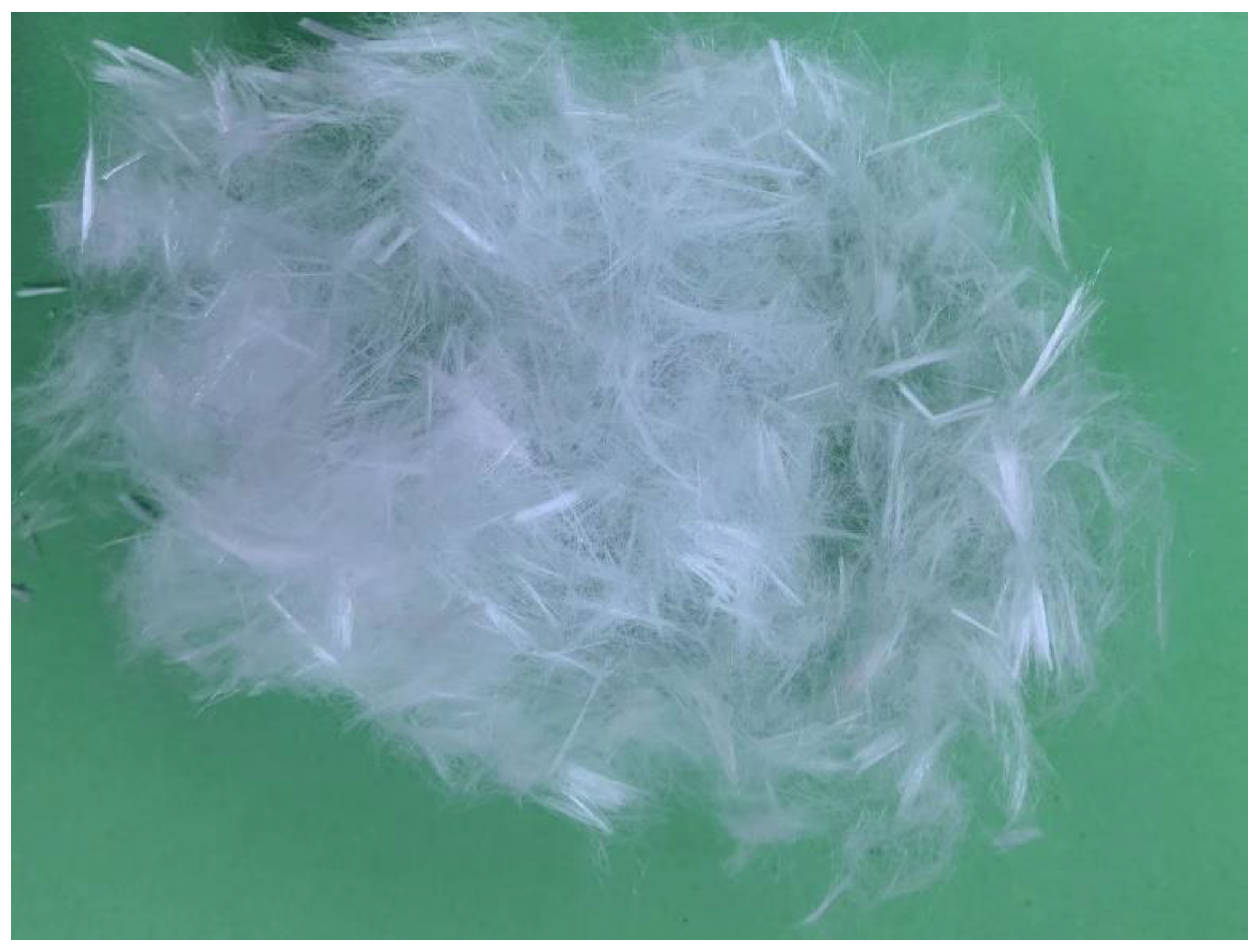
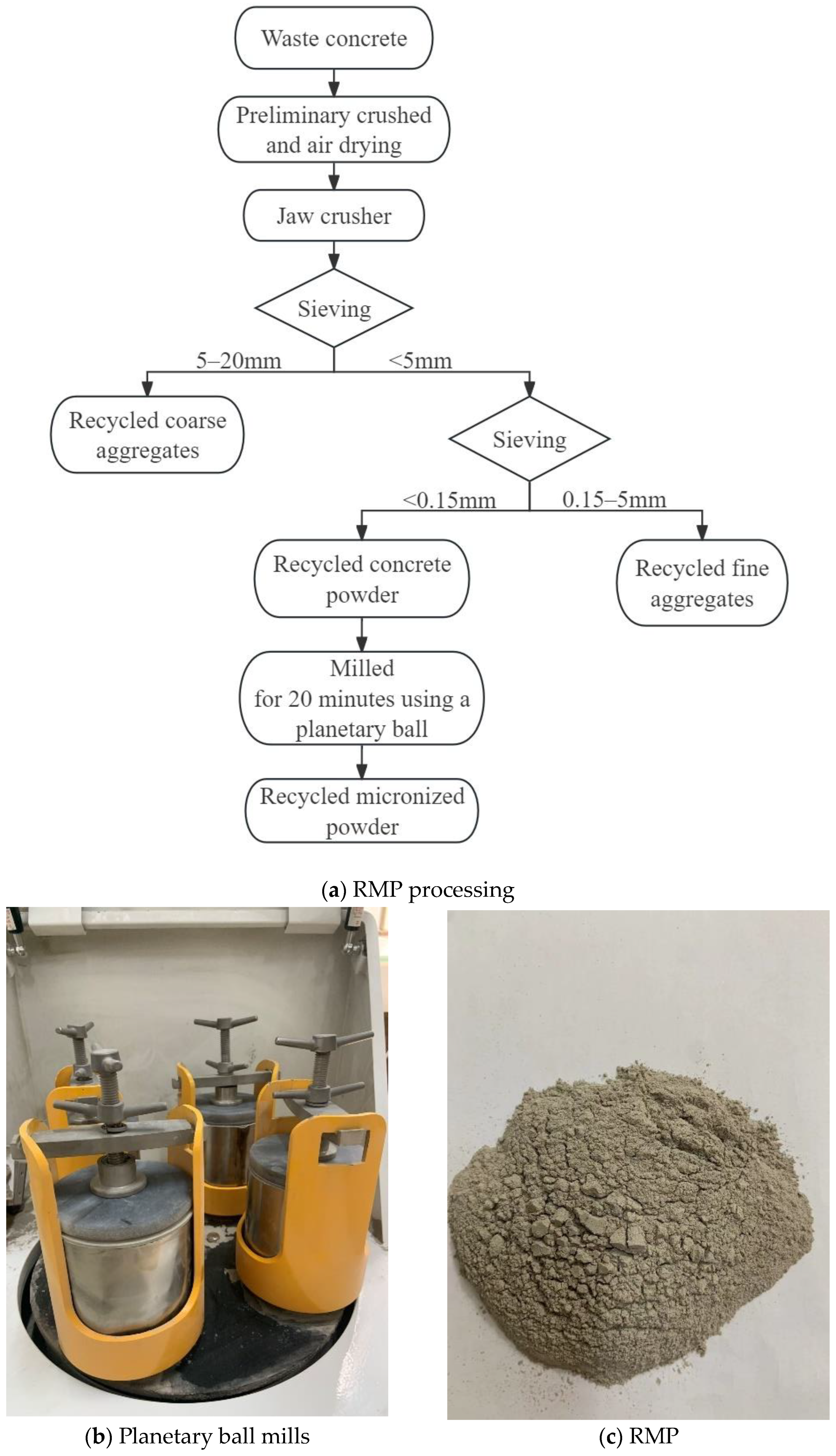
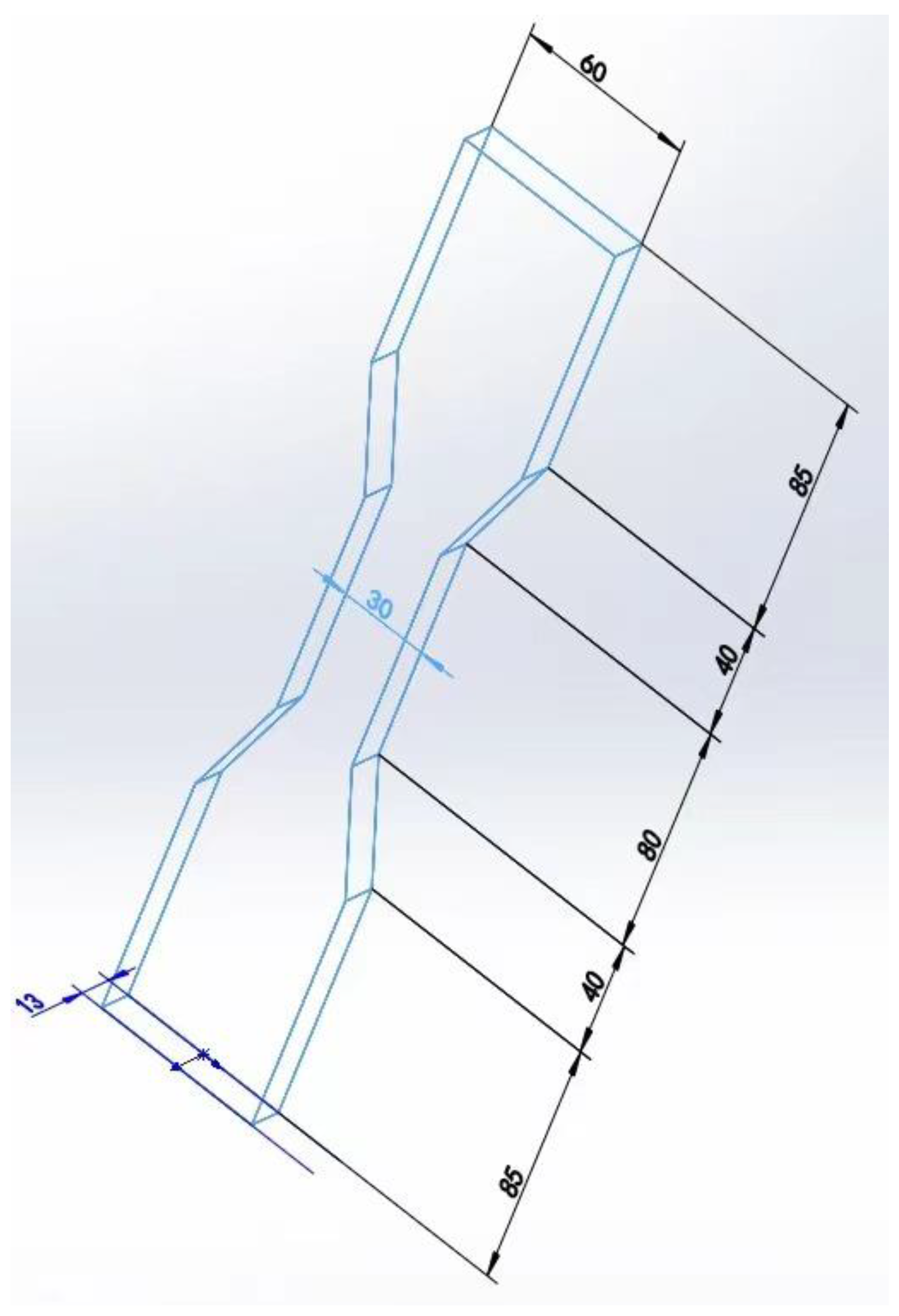
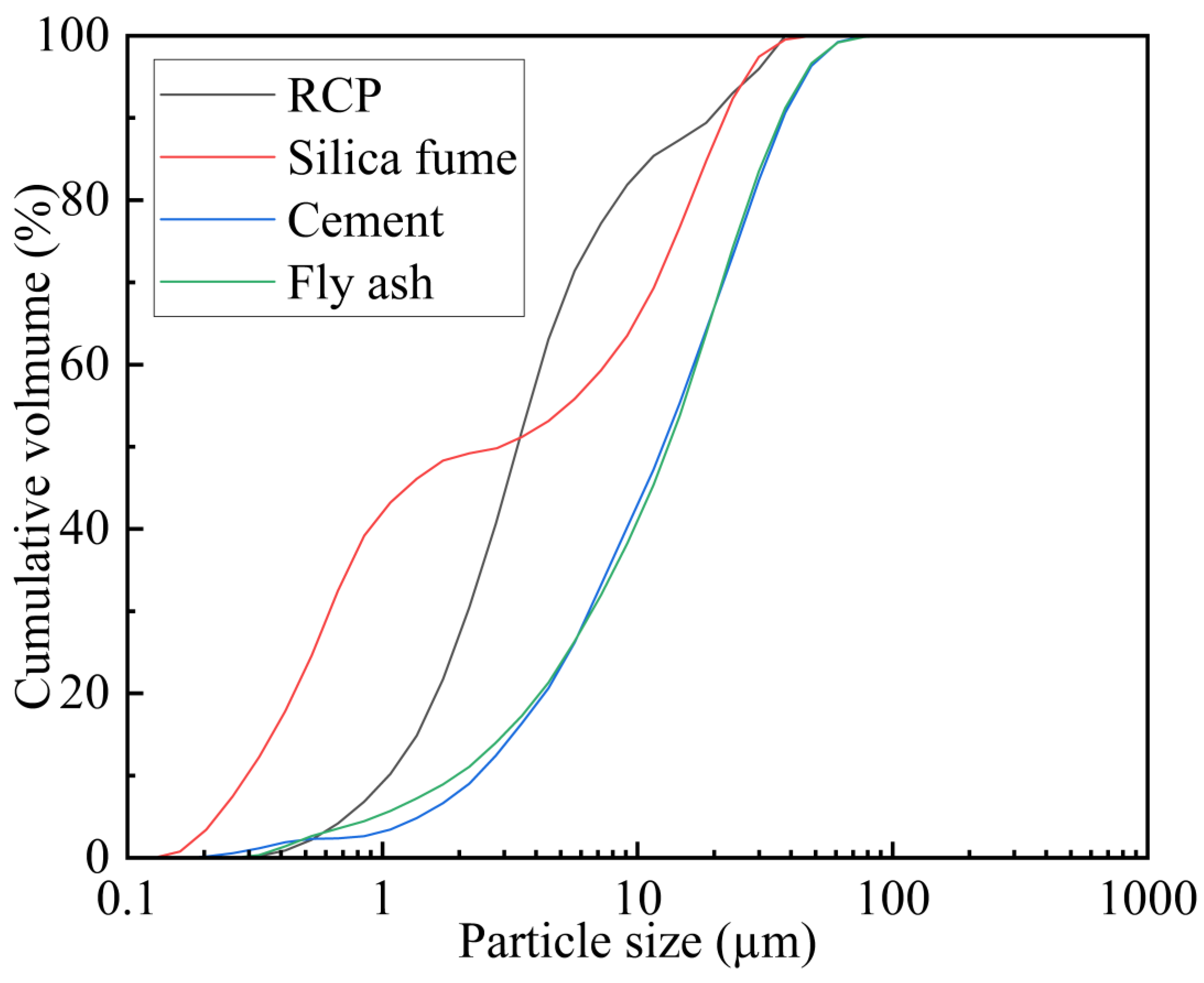





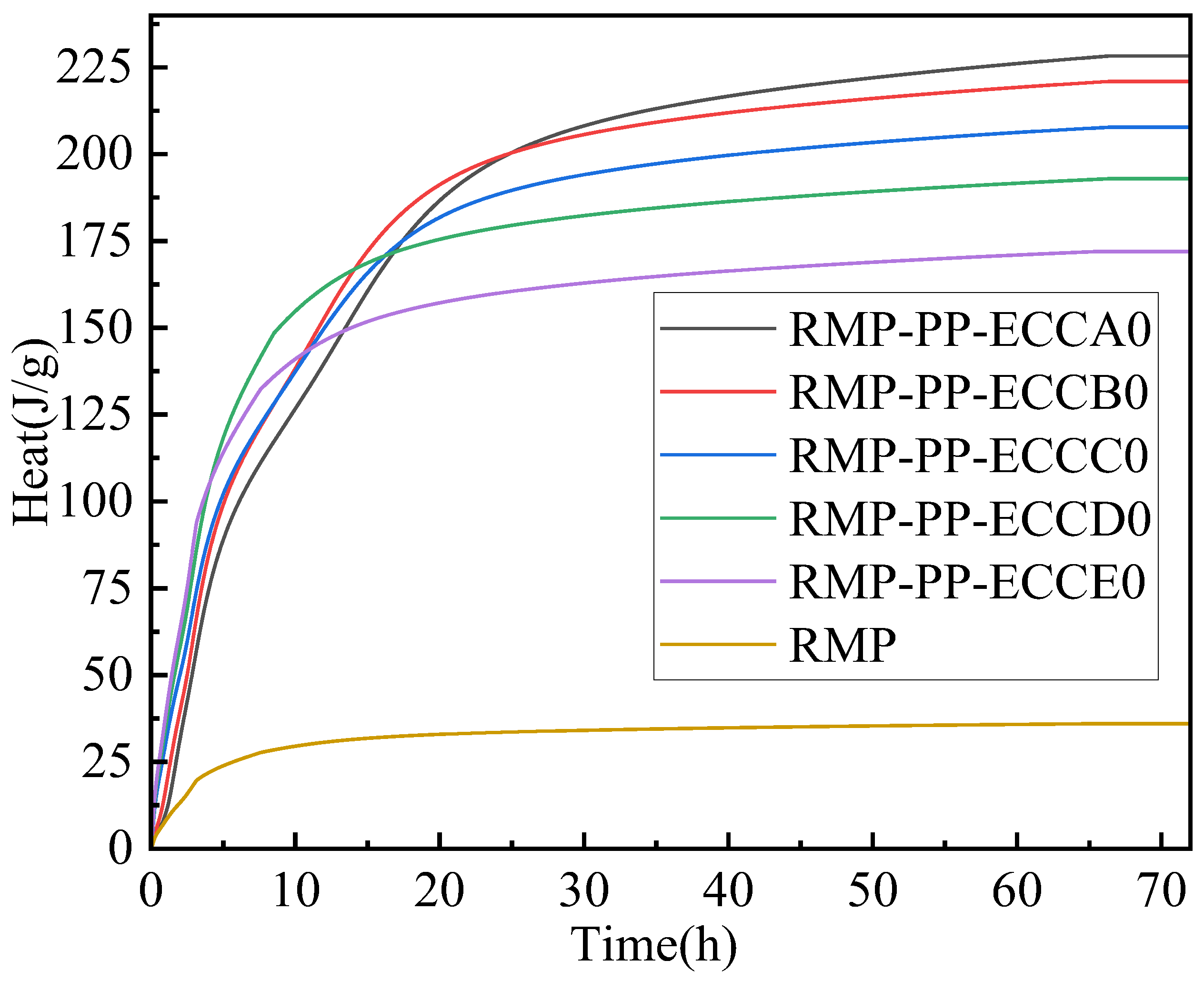
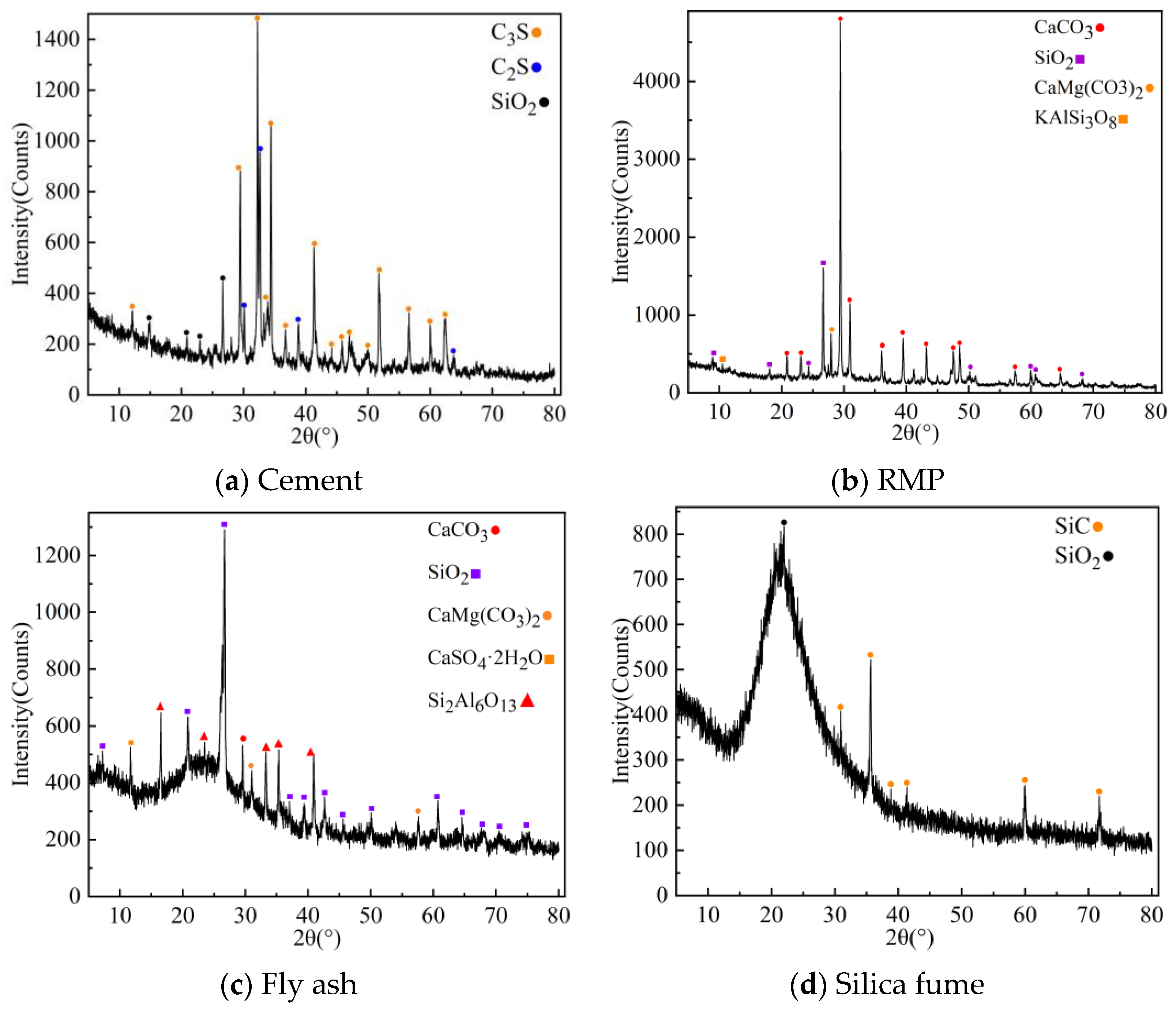
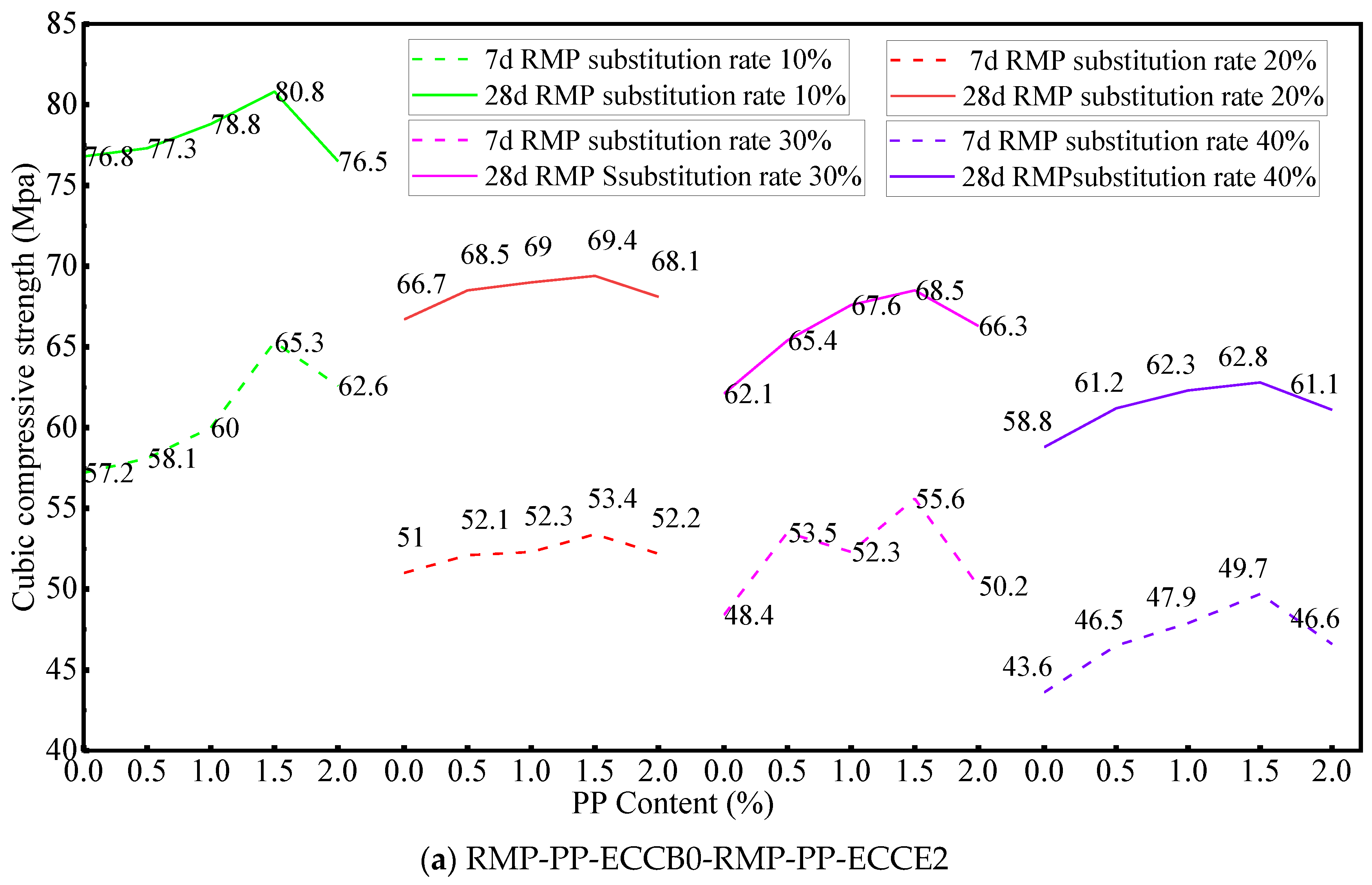

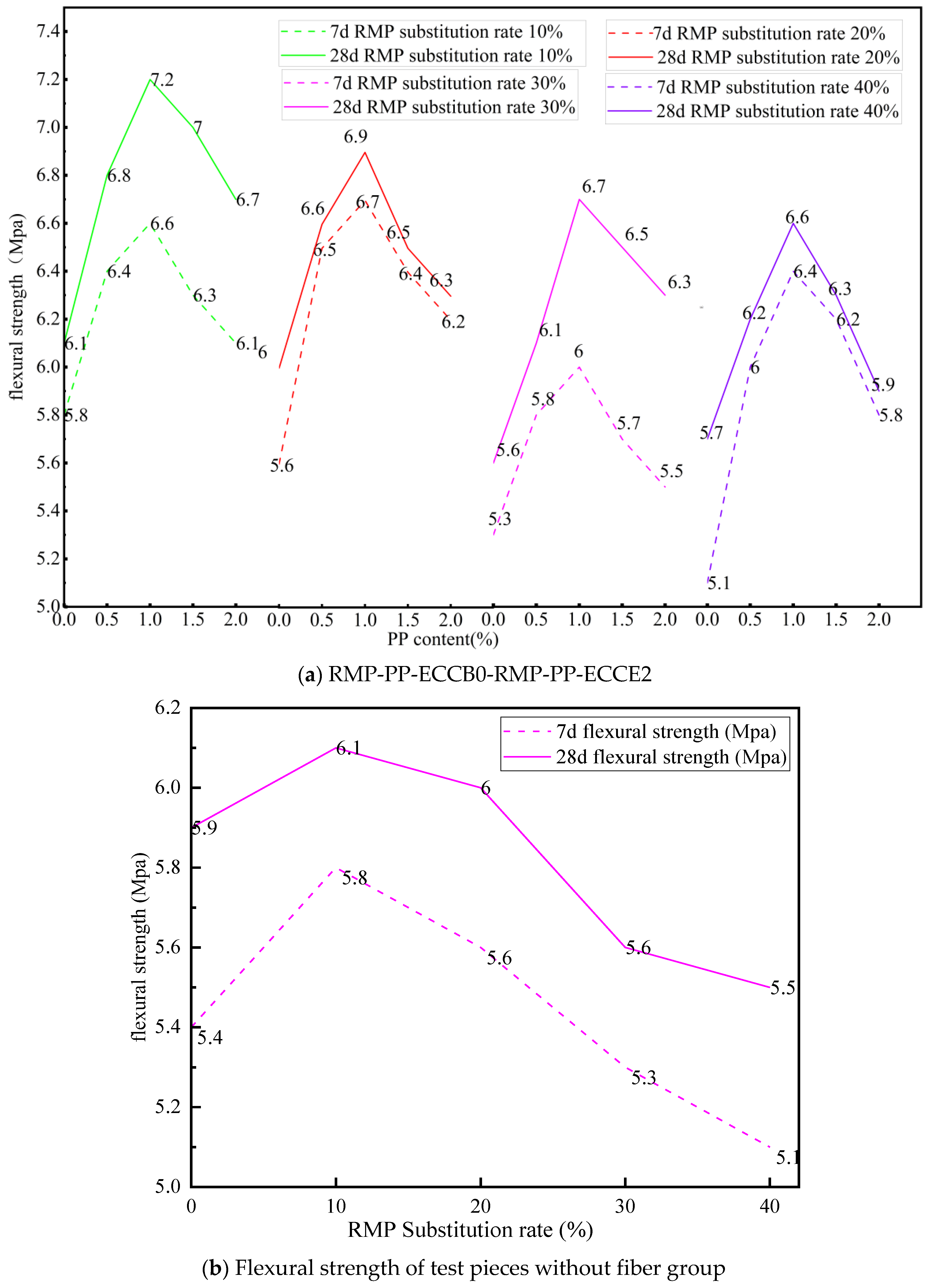
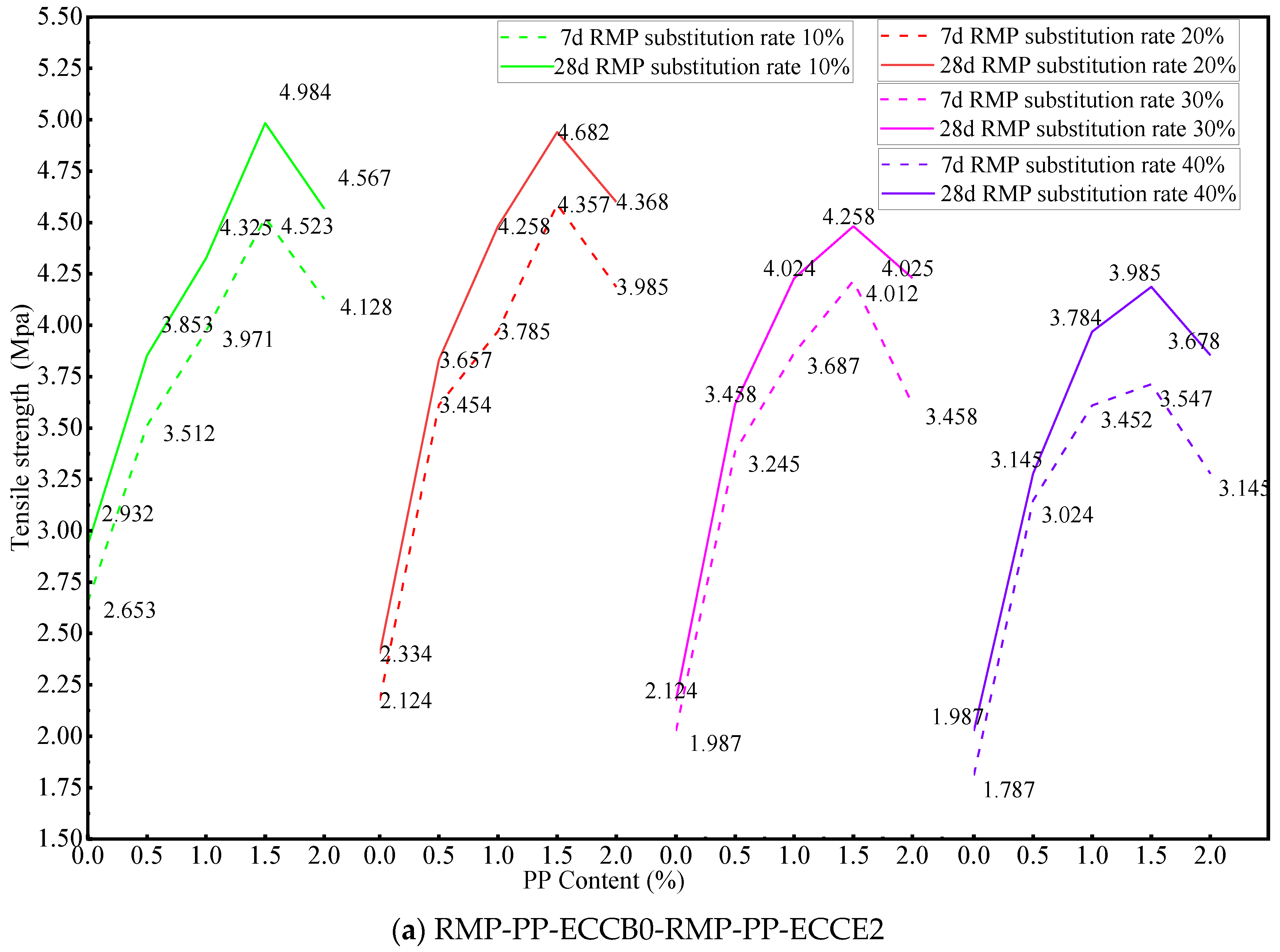

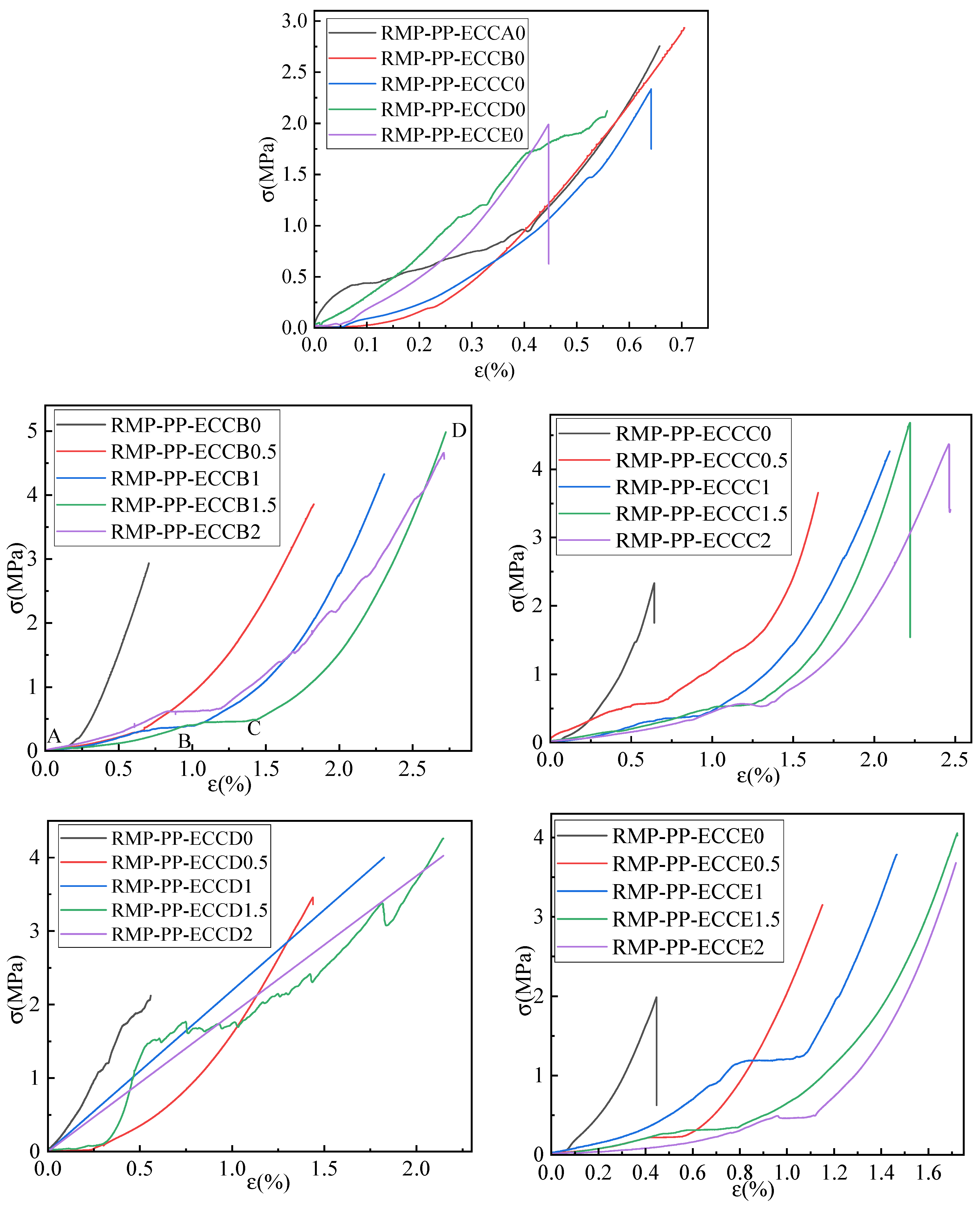



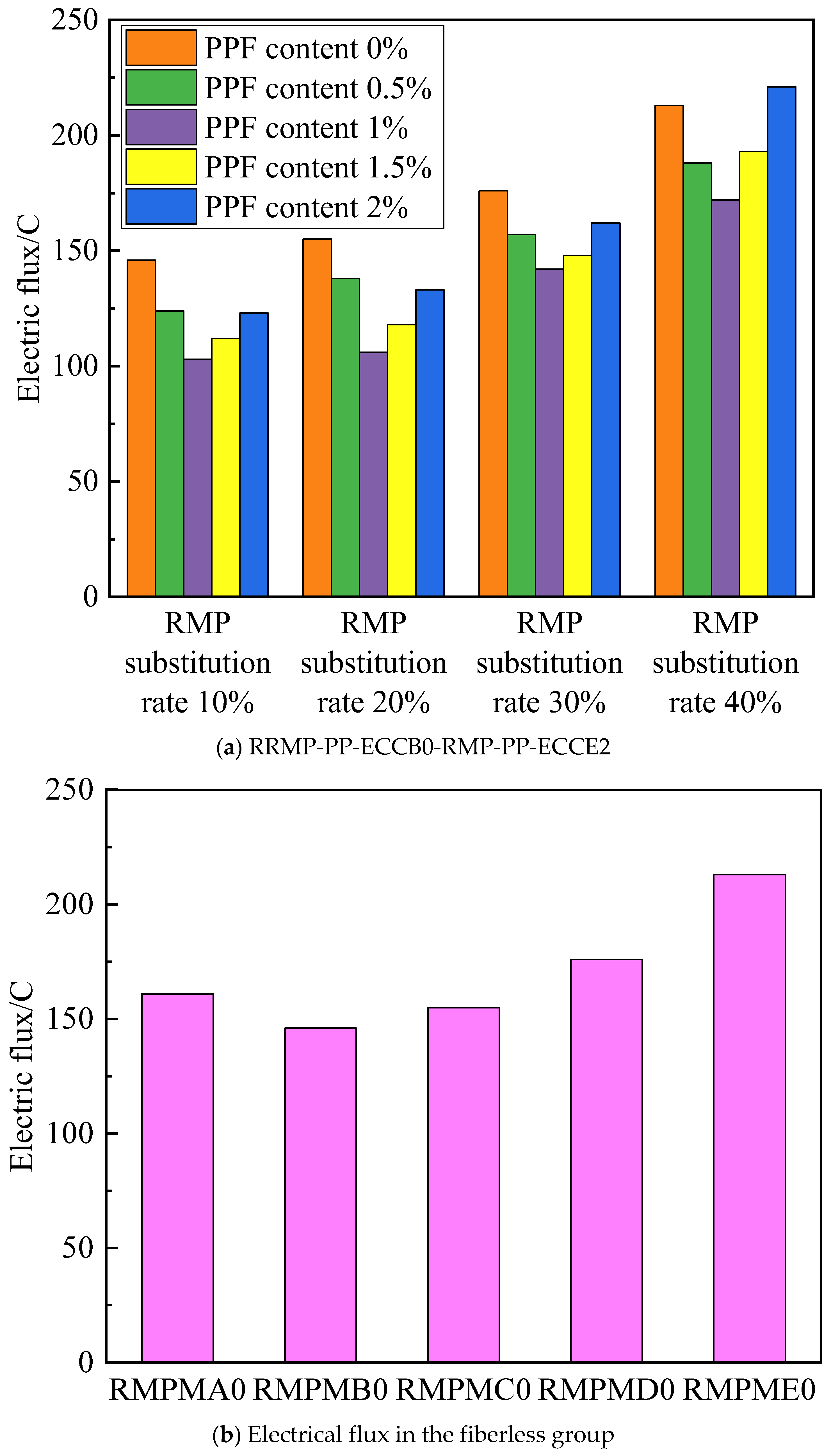
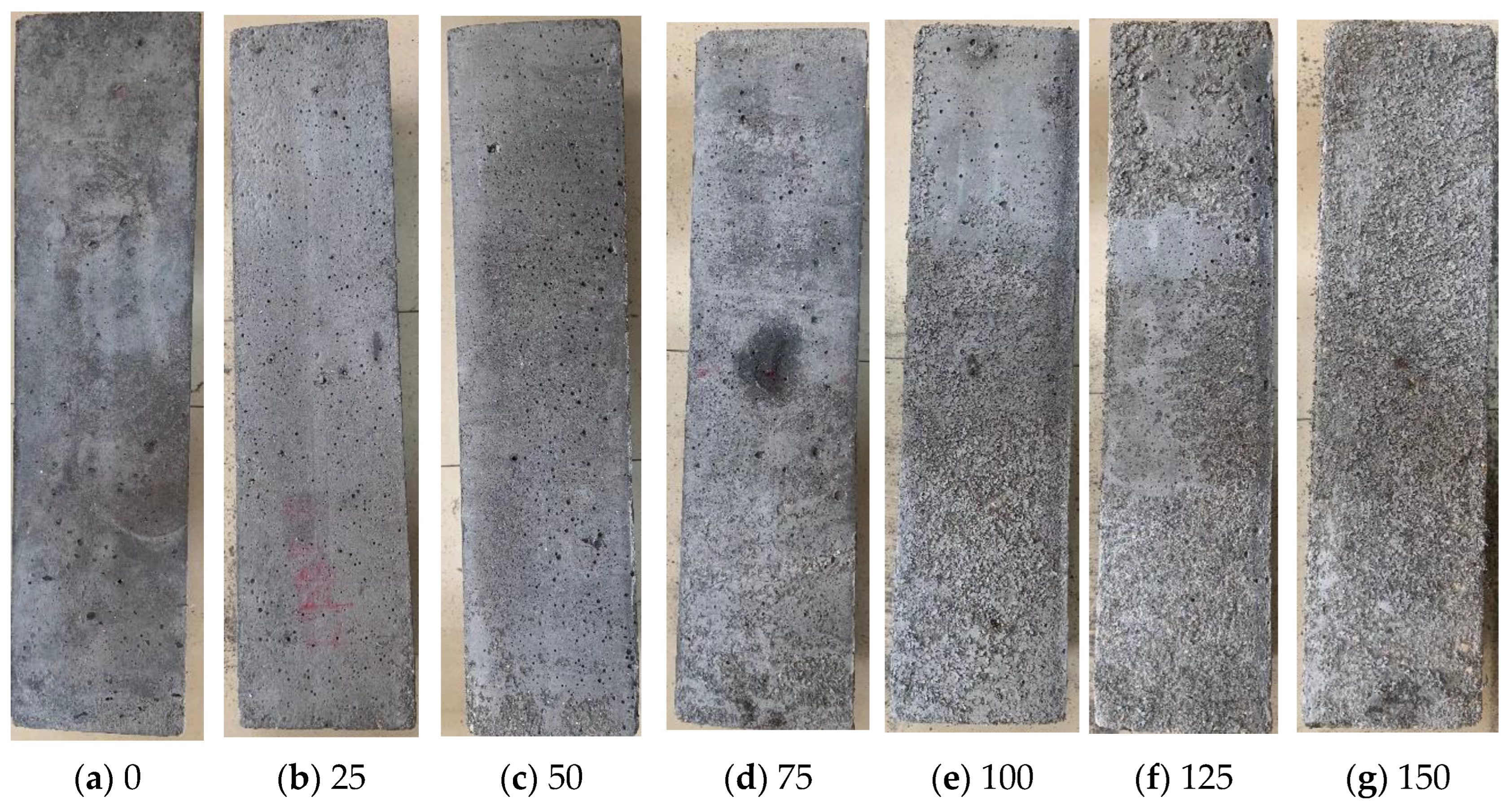
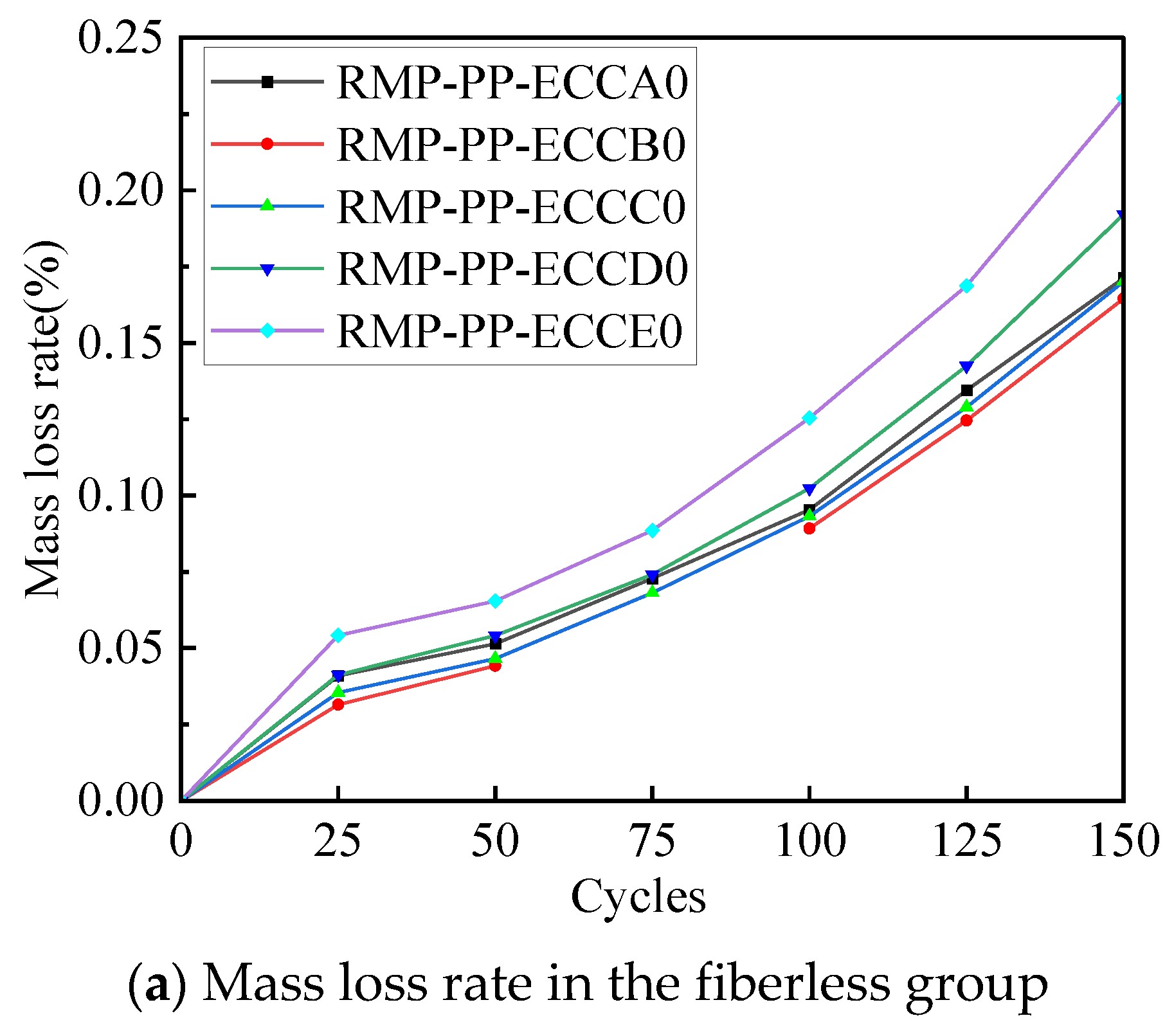
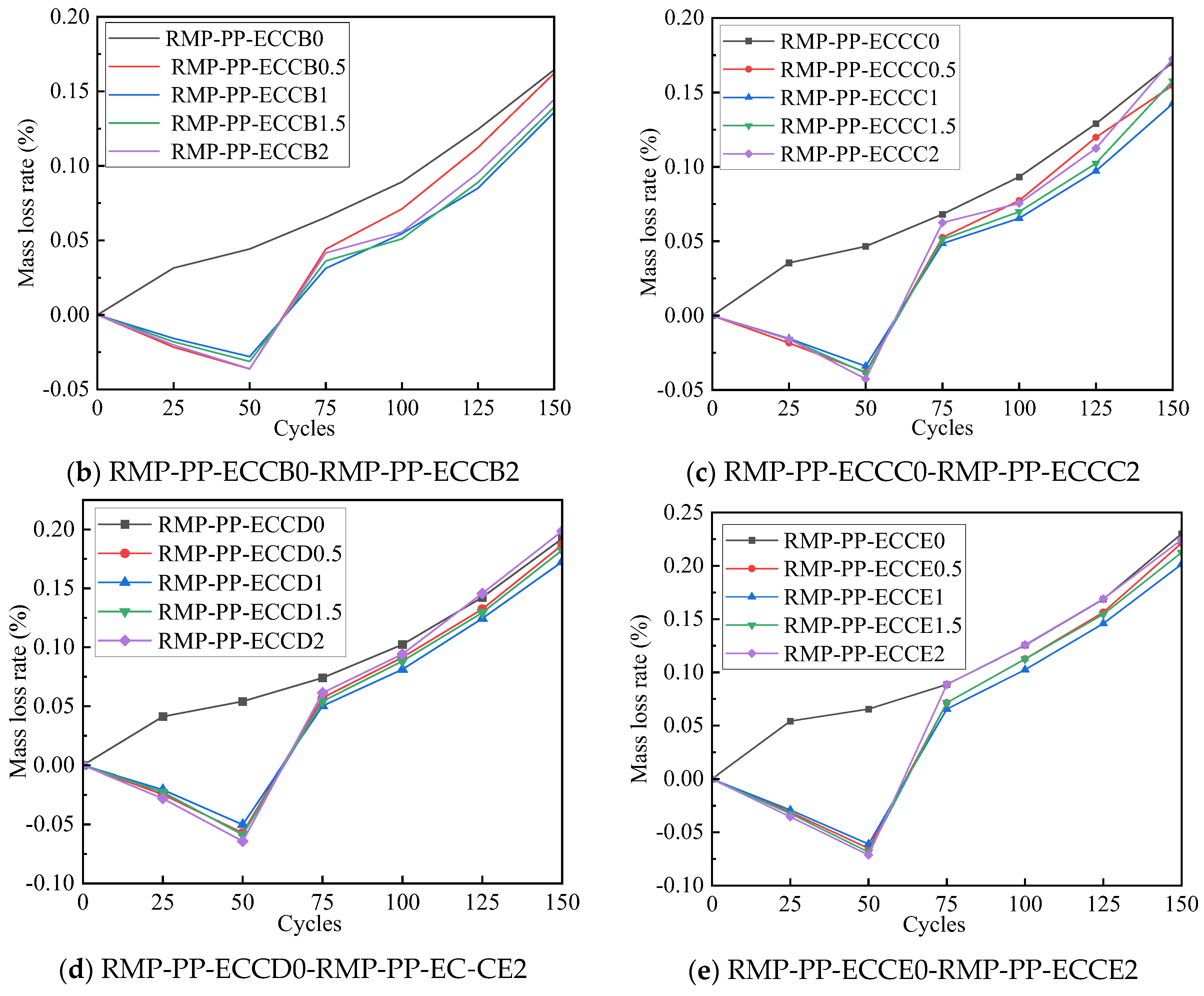
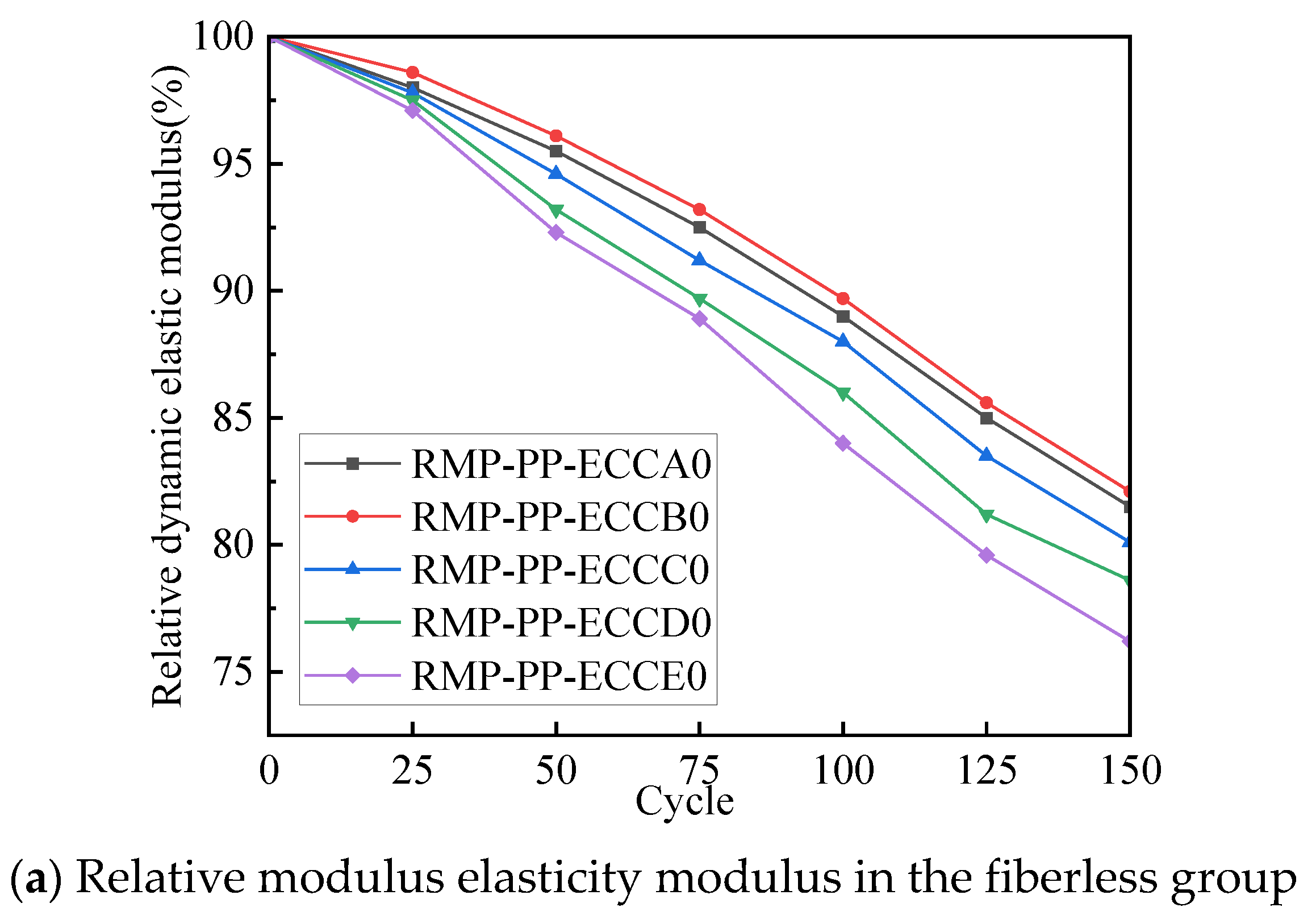
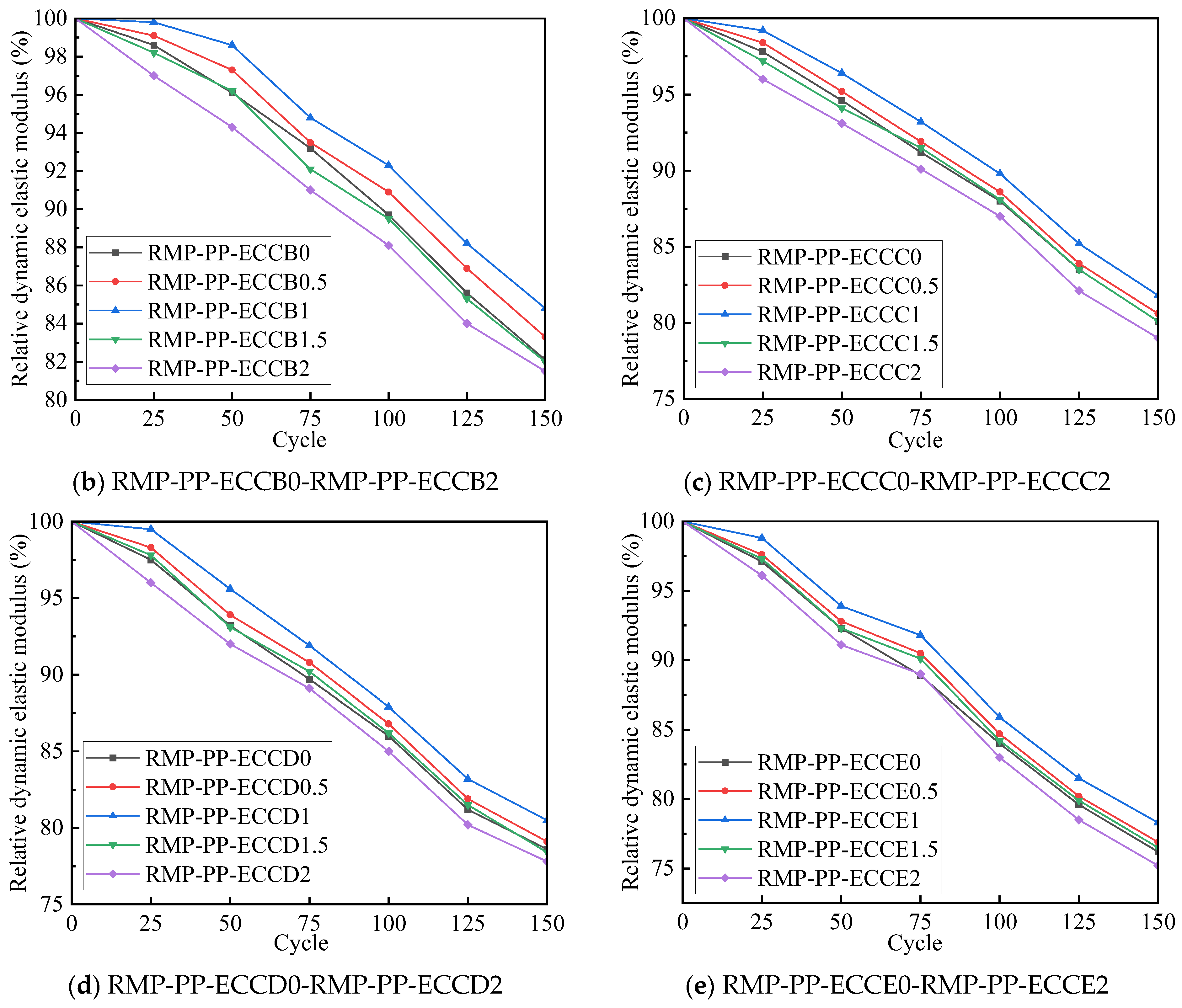
| Material | CaO | SiO2 | Fe2O3 | Al2O3 | SO3 | K2O | MgO | TiO2 | Na2O |
|---|---|---|---|---|---|---|---|---|---|
| Cement | 48.56 | 26.54 | 3.44 | 12.45 | 4.87 | 0.67 | 2.45 | 0.67 | 0.35 |
| RMP | 42.54 | 25.34 | 2.35 | 5.54 | 0.87 | 1.26 | 2.64 | 0.32 | 0.65 |
| Fly ash | 1.47 | 54.07 | 4.01 | 26.83 | 0.85 | 1.54 | 1.36 | 1.56 | 0.54 |
| Silica fume | 0.23 | 94.35 | 0.21 | 0.21 | 0.32 | 0.21 | 0.41 | 0.11 | 0.15 |
| Fiber Type | Density | Tensile Strength | Elongation at Break | Length | Moisture Content | Young’s Modulus | Diameter |
|---|---|---|---|---|---|---|---|
| (kg·m−3) | (MPa) | (%) | (mm) | (%) | (GPa) | (μm) | |
| PP | 910 | 350 | 35 | 6 | 2 | 3.5 | 35 |
| Mixture | Cement | RMP | Fly Ash | Silica Fume | Sand | PP Fiber | Water | EWR |
|---|---|---|---|---|---|---|---|---|
| (g) | (g) | (g) | (g) | (g) | (%) | (g) | (g) | |
| RMP-PP-ECCA | 800 | 0 | 100 | 100 | 1000 | 0 | 250 | 29 |
| RMP-PP-ECCB0 | 720 | 80 | 100 | 100 | 1000 | 0 | 250 | 29 |
| RMP-PP-ECCB0.5 | 720 | 80 | 100 | 100 | 1000 | 0.5 | 250 | 29.5 |
| RMP-PP-ECCB1 | 720 | 80 | 100 | 100 | 1000 | 1 | 250 | 30 |
| RMP-PP-ECCB1.5 | 720 | 80 | 100 | 100 | 1000 | 1.5 | 250 | 31 |
| RMP-PP-ECCB2 | 720 | 80 | 100 | 100 | 1000 | 2 | 250 | 31.5 |
| RMP-PP-ECCC0 | 640 | 160 | 100 | 100 | 1000 | 0 | 250 | 29 |
| RMP-PP-ECCC0.5 | 640 | 160 | 100 | 100 | 1000 | 0.5 | 250 | 29.5 |
| RMP-PP-ECCC1 | 640 | 160 | 100 | 100 | 1000 | 1 | 250 | 30 |
| RMP-PP-ECCC1.5 | 640 | 160 | 100 | 100 | 1000 | 1.5 | 250 | 31 |
| RMP-PP-ECCC2 | 640 | 160 | 100 | 100 | 1000 | 2 | 250 | 31.5 |
| RMP-PP-ECCD0 | 560 | 240 | 100 | 100 | 1000 | 0 | 250 | 29 |
| RMP-PP-ECCD0.5 | 560 | 240 | 100 | 100 | 1000 | 0.5 | 250 | 29.5 |
| RMP-PP-ECCD1 | 560 | 240 | 100 | 100 | 1000 | 1 | 250 | 30 |
| RMP-PP-ECCD1.5 | 560 | 240 | 100 | 100 | 1000 | 1.5 | 250 | 31 |
| RMP-PP-ECCD2 | 560 | 240 | 100 | 100 | 1000 | 2 | 250 | 31.5 |
| RMP-PP-ECCE0 | 480 | 320 | 100 | 100 | 1000 | 0 | 250 | 29 |
| RMP-PP-ECCE0.5 | 480 | 320 | 100 | 100 | 1000 | 0.5 | 250 | 29.5 |
| RMP-PP-ECCE1 | 480 | 320 | 100 | 100 | 1000 | 1 | 250 | 30 |
| RMP-PP-ECCE1.5 | 480 | 320 | 100 | 100 | 1000 | 1.5 | 250 | 31 |
| RMP-PP-ECCE2 | 480 | 320 | 100 | 100 | 1000 | 2 | 250 | 31.5 |
Disclaimer/Publisher’s Note: The statements, opinions and data contained in all publications are solely those of the individual author(s) and contributor(s) and not of MDPI and/or the editor(s). MDPI and/or the editor(s) disclaim responsibility for any injury to people or property resulting from any ideas, methods, instructions or products referred to in the content. |
© 2023 by the authors. Licensee MDPI, Basel, Switzerland. This article is an open access article distributed under the terms and conditions of the Creative Commons Attribution (CC BY) license (https://creativecommons.org/licenses/by/4.0/).
Share and Cite
Zheng, L.; Zhou, J. Mechanical, Chloride Permeation, and Freeze–Thaw Resistance of Recycled Micronized Powder Polypropylene-Fiber-Engineered Cementitious Composites. Buildings 2023, 13, 2755. https://doi.org/10.3390/buildings13112755
Zheng L, Zhou J. Mechanical, Chloride Permeation, and Freeze–Thaw Resistance of Recycled Micronized Powder Polypropylene-Fiber-Engineered Cementitious Composites. Buildings. 2023; 13(11):2755. https://doi.org/10.3390/buildings13112755
Chicago/Turabian StyleZheng, Lei, and Jinzhi Zhou. 2023. "Mechanical, Chloride Permeation, and Freeze–Thaw Resistance of Recycled Micronized Powder Polypropylene-Fiber-Engineered Cementitious Composites" Buildings 13, no. 11: 2755. https://doi.org/10.3390/buildings13112755
APA StyleZheng, L., & Zhou, J. (2023). Mechanical, Chloride Permeation, and Freeze–Thaw Resistance of Recycled Micronized Powder Polypropylene-Fiber-Engineered Cementitious Composites. Buildings, 13(11), 2755. https://doi.org/10.3390/buildings13112755





